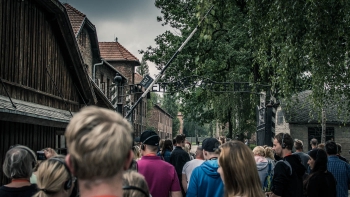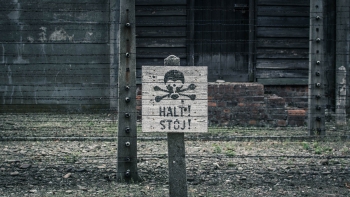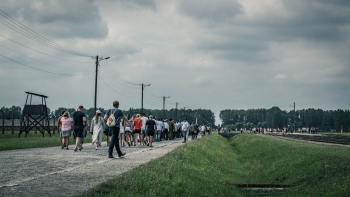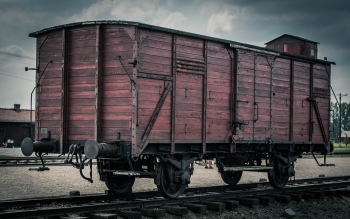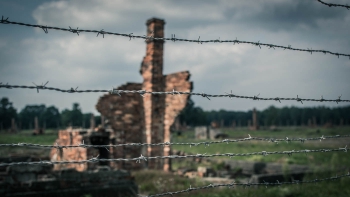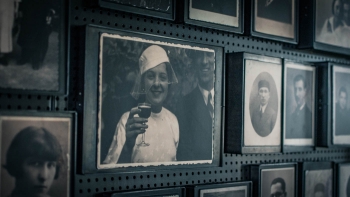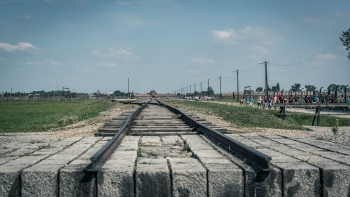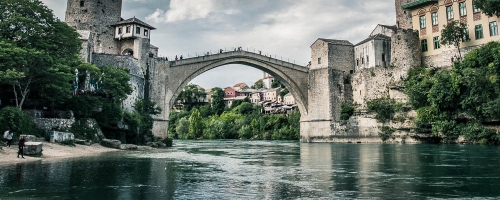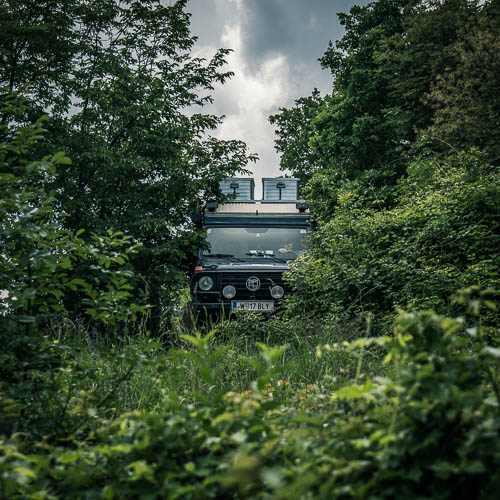
Between selfie-sticks and commemoration
Written by am on 04.12.2017 at 17:09.
Thoughts on our visit to the Auschwitz-Birkenau Memorial and Museum
Tense and awestruck by the history that has been written on this ground, we head towards a small town in Poland called Oświęcim, better known under its German name “Auschwitz” that became a synonym for the Holocaust. A few road signs silently point the way through the unimposing town to the memorial site and museum of the former German Nazi concentration and extermination camp Auschwitz-Birkenau.
Next stop - Disneyland?
Literally at the end of the road, a sudden change of scene to which we were not prepared on this hot day in August: fully loaded coaches, hectic car-park attendants, colorful kiosks selling snacks and people who are sitting in the adjacent meadow eating them. A long queue hints us to the information desk where the entry tickets can be purchased. A little bit disturbed by this turmoil, we decide to come back early the next morning hoping for less visitors.
 Visitors waiting for entering the area of Auschwitz I.
Visitors waiting for entering the area of Auschwitz I.What did we expect to find? Respect. Silence. Commemoration. Appreciation of the murdered. A memorial. And what impression did we get? A blemish of humanity that degenerates to entertainment? Perhaps our judgment is too hard, our first impressions too short and therefore wrong?
On the way to our camp spot for the night we discuss the pros and cons of so many visitors in Auschwitz-Birkenau. Yes, as many people as possible should see this place with their own eyes, remember what fascism and fanaticism can lead to and realize that it should never occur again. But no, the masses visiting this place cannot happen at any cost. Auschwitz-Birkenau must never become an Eldorado for adventure tourists, whose visit to the former German extermination camp is driven by pure curiosity, only seeking for some thrill in their otherwise monotonous holidays. It must never degenerate into a tourist attraction, a banal destination, which you randomly visit on the way to the next sightseeing spot.
The visiting day
One day later, it's 6:45 am, 45 minutes before the ticket office opens. We arrive at the car park in front of the museum and are immediately directed to a space by the parking attendant. Not only we had the idea to be there so early, but also about 30 other people already waiting in line at the ticket counter. The former concentration camp is divided into two sites (“Auschwitz I” and “Auschwitz II-Birkenau”). Both can be visited individually or in a group accompanied by a so-called "educator". We clearly decide for the latter.
 Visitors taking pictures of the gate with the phrase "Arbeit macht frei".
Visitors taking pictures of the gate with the phrase "Arbeit macht frei".The tour starts on the area of Auschwitz I, where every visitor has to pass through the gate topped with the words "Arbeit macht frei". The gate is the first stop of the tour and like a bottleneck, as the path is obstructed by people photographing the gate. We take the obligatory picture with mixed feelings.
Our group is of course not the only one on the premises - there is a crowd in front of the first building converted into a museum and we have to wait to get in. I catch myself as I meticulously take care not to step on my front man’s heels instead of noticing consciously what place I do enter now.
The educator takes us through the rooms, it is stuffy and cramped in the hallways. We are stopping at several photos, objects or documents. The educator's voice is gentle but insistent, she makes small breaks between her explanations - I assume to give the listeners time to process what they had heard.
 Suitcases of victims killed in Auschwitz-Birkenau.
Suitcases of victims killed in Auschwitz-Birkenau.Mass deportation. Selection. Forced labor. Gas chambers. Crematoria. Men, women, children. 1.1 million - dead. I try to focus on her voice while at the same time looking at the countless exhibits displayed in the rooms. I lose myself in their stories, I only notice that "my group" had moved on, as the audio signal of the headphones gets weaker.
What remains of the murdered?
Their suitcases. The name and address of the owner are handwritten on almost all of them - sometimes hastily, sometimes with great care.
Their shoes. In the mass of shoes that pile up in front of me, my eyes come to rest upon a certain single shoe. "Who was wearing this shoe?"
Their glasses. "Which books did the wearer prefer to read?" Their hair - mercilessly forming a seemingly endless pile. I stop asking myself questions. The sight of the hair that was cut off the victims, floods my eyes with tears.
 Every face tells a story.
Every face tells a story.Some walls of the corridors in the building, which the groups go in single file, are paved with photos of murdered men, women and children. As I walk past, I try to read their names. As soon as I stop for a few minutes I realize the impatience of the person behind me. Move and keep moving! But I feel that I owe the victims that I consciously notice their faces and quietly pronounce their names. My minor contribution to commemorate the dead. Ultimately I am unable to do them justice. There are too many faces, too many names. I give up, look down ashamed and follow my group wordlessly.
Outside the building I look into the faces of the living, I try to read them. How are they? Do they feel the same? How can some seem to be so carefree at a place like this?
On the site of the former concentration camp “Auschwitz II-Birkenau”, which is about 3.5 km away from Auschwitz I, our educator continues her work with the same professionalism. She leads us towards the so-called unloading platform or ramp - the spot where the trains with deported individuals stopped and where the selection took place.
 Railcar used for deportation of people to Auschwitz.
Railcar used for deportation of people to Auschwitz.The lonely parked railcar in the middle of the tracks seems to be a particularly popular photo background. It is beyond my imagination why anyone should pose for a photo in front of this train. But many visitors do.
The walk from the ramp to the rear, inconspicuous part of the terrain, is almost unbearable to me. These are the meters that led to the gas chambers and crematorium. The buildings no longer exist today, only fragments of their walls have remained.
The terrain seems endless - barracks over barracks (or what is left). Disease, hunger, suffering were at home in these buildings, where hundreds of thousands of people were accommodated against their will. They are silent witnesses, but their mere existence tells the visitors about the terrible events that took place here more than 70 years ago.
Take your time
Auschwitz-Birkenau is a place where the incomprehensibility of the Holocaust becomes comprehensible to later generations. Between the masses of people armed with selfie-sticks, it may not be easy for everyone to engage with the seen and heard.
 The dimensions of the former concentration camp are frightening. Off the beaten tracks of the guided tours one can find unnoticed, lonely spots to deal with this place in peace.
The dimensions of the former concentration camp are frightening. Off the beaten tracks of the guided tours one can find unnoticed, lonely spots to deal with this place in peace.But there are places on the premises of the Auschwitz-Birkenau memorial sites that make one come to an unexpected calm. Time is an essential factor. Sufficient time should be planned for the visit in order to take a history lesson off the beaten tracks of the guided tours: visit the various exhibitions in the buildings converted into museums and explore the history of the hidden, unimpressive building ruins in the adjacent forest.
The following days we are still pondering over our visit to the former german Nazi concentration and extermination camp. We continue our discussion from the previous day, still under the impression that many of the visitors are unaware of the importance of their visit, instead behaving like low-brow day-tripper in an amusement park.
But in times of rising right-wing populism, it is more important than ever to wholeheartedly face this dark but inextinguishable chapter of human history. A visit to Auschwitz-Birkenau as a memorial to “never-forget” is certainly a proper opportunity for this, but only if it happens with the appropriate behavior; respecting and commemorating the victims of the National Socialism. And please, without a selfie-stick.



